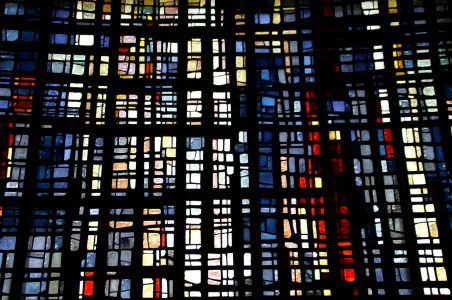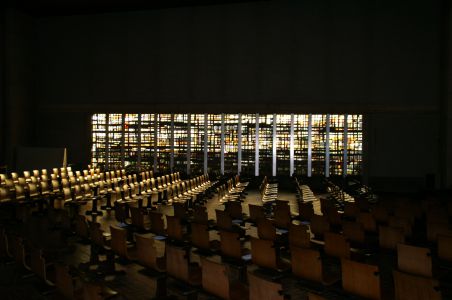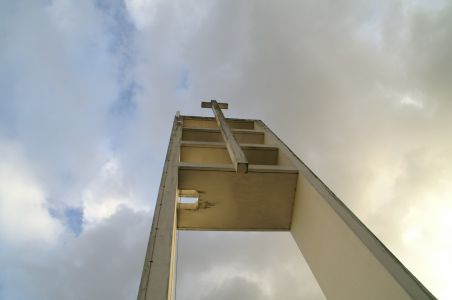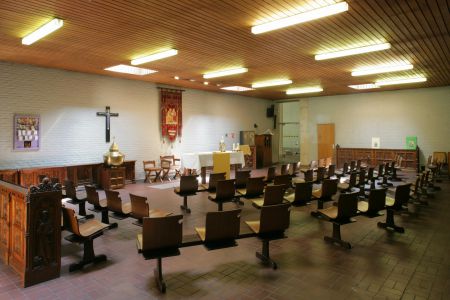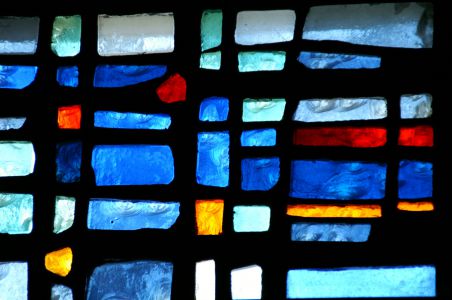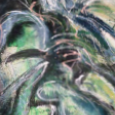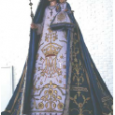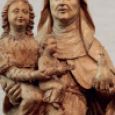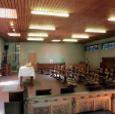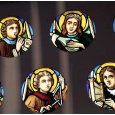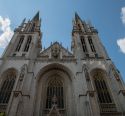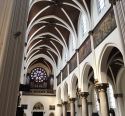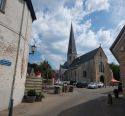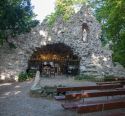Church | 1963-1970 | Modern | Catholic Church







Map
Opening hours
01 July - 30 September
Mon -
Tue -
Wed -
Thu -
Fri -
Sat 14.00 - 17.00
Sun 14.00 - 17.00
Religious offices
Description
This modern church, dating from 1970, has been officially called Saint Anne the Trinity since 2006 due to the presence of a 1667 statue depicting the Virgin, her mother, Anne, and Jesus. The statue refers to the chapel of Saint Anne which has been a pilgrimage site since 1330. The people of Antwerp colloquially call this place “Saint Annie “ with pride and affection and its surroundings along the river Scheldt, “Saint Annie’s beach”.
While planning this modern church , the architect Jos Ritzen also thought of a multi- purpose location. This is why the interior is in the form of a scallop with no element interfering with the view of the whole. The stained glass windows are the work of the Frenchman, Jacques Loire of Chartres. In 2012 this artist created a very contemporary glass tabernacle illuminated from inside. The various artists who have exhibited recently in the church have left one or other of their creations.
As the altar can be moved and the floor is slightly inclined, the church is an ideal place for concerts and exhibitions. Every year since 2009 the church has hosted a summer exhibition and 15 to 20 concerts are given. For the cultural activities in the church see: www.anna3.be
Since 2011 the church is the first “church for cycles”. You can picnic outside while leaving your cycle in a shelter (a rubbish container, drinkable water, toilets and points for recharging electric cycles are all available). The church has also initiated the “Scheldt church route”, a cycle track along the banks of the Scheldt as far as Rupelmonde. Short- cuts are possible via various branches of the Scheldt. A map of this route is on sale at the church.
The church is also a truly ecological church protected by various techniques: the whole building is lit by LED’s powered by 48 solar panels, rain water is collected for the toilets, rubbish is sorted, and it uses fair trade products
KIKIRPA : Photo-library online
Photos
Media
Remarkable elements
Schilderij
Painting Willem Vermandere toured Flanders and The Netherlands for years with his art. The church bought this piece after the summer exhibition in 2009. The painting received a special place in this church.Processiebeeld
Statue for procession This statue from 1899, specifically made for processions, of Our Lady wears a gold-brocade robe, which is decorated with lily-like flowers, roses, and festoons with nine devout virtues: piety, humility, patience, grief, poverty, love, faith, purity, and obedience.Sint-Anna-ten-Drieën-beeld
Saint-Anna-Trinitas-Terrestris- statue The lime wood Saint-Anna- Trinitas-Terrestris statue (“Earthly Trinity”) (1667, artist unknown) displays Saint Anna with her daughter Maria and her grandson Jesus. Saint Anna caries a pear, the symbol for fertility and longevity, in her left hand.Weekkapel
Chapel used during the week You can find all kinds of furniture from the second (neo-Gothic) church, which was built in 1903 on this spot but demolished again in 1968, in the chapel used during the week. The current church is the third church.Engelen
Angels Music-making angels. These small stained glass windows were made of the rose windows from the former church and were restored to celebrate the mark of 100 years of the St.Anna parish in 1993.Saint Anne / Choir ladies - 2021 campaign
Recovered from the Chapel of Saint Anne, this wooden statue from 1667 personifies the natural cycle of the past, present and future. Saint Anne carries her daughter Mary and her grandson Jesus in her arms.
This work contrasts with the ultra-modern architecture of the building that now houses it.



